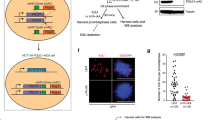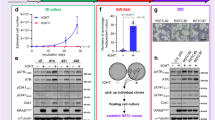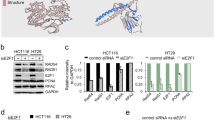Abstract
Oncogene-induced replication stress is recognized as the primary cause of accumulation of DNA damage and genome instability in precancerous cells. Although the molecular mechanisms responding to such type of replication perturbation are not fully characterized, it has been speculated that their dysfunction may enhance genome instability and accelerate tumor progression. Here, we show that the WRN protein, a member of the human RecQ helicases, is necessary to sustain replication fork progression in response to oncogene-induced replication stress. Loss of WRN affects cell cycle progression and results in enhanced accumulation of double-strand breaks and instability at common fragile sites in cells experiencing oncogene-induced replication stress. Moreover, we demonstrate that double-strand breaks, observed upon oncogene over-expression, depend on the MUS81 endonuclease, which represents a parallel pathway collaborating with WRN to prevent cell death. Overall, our findings give insights into the mechanisms protecting replication forks in cells experiencing oncogene-induced replication stress, and identify factors that, when mutated or dysfunctional, may enhance genome instability in precancerous cells. In addition, because concomitant depletion of WRN and MUS81 causes synthetic sickness in cells growing under oncogene-induced replication stress, our results support the possibility of targeting cancer cells with an impaired replication fork recovery pathway by a specific inactivation of the other parallel pathway.
This is a preview of subscription content, access via your institution
Access options
Subscribe to this journal
Receive 50 print issues and online access
$259.00 per year
only $5.18 per issue
Buy this article
- Purchase on Springer Link
- Instant access to full article PDF
Prices may be subject to local taxes which are calculated during checkout





Similar content being viewed by others
References
Negrini S, Gorgoulis VG, Halazonetis TD . Genomic instability--an evolving hallmark of cancer. Nat Rev Mol Cell Biol 2010; 11: 220–228.
Walther A, Houlston R, Tomlinson I . Association between chromosomal instability and prognosis in colorectal cancer: a meta-analysis. Gut 2008; 57: 941–950.
Halazonetis TD, Gorgoulis VG, Bartek J . An oncogene-induced DNA damage model for cancer development. Science 2008; 319: 1352–1355.
Bester AC, Roniger M, Oren YS, Im MM, Sarni D, Chaoat M et al. Nucleotide deficiency promotes genomic instability in early stages of cancer development. Cell 2011; 145: 435–446.
Branzei D, Foiani M . Maintaining genome stability at the replication fork. Nat Rev Mol Cell Biol 2010; 11: 208–219.
Allen C, Ashley AK, Hromas R, Nickoloff JA . More forks on the road to replication stress recovery. J Mol Cell Biol 2011; 3: 4–12.
Ciccia A, Elledge SJ . The DNA damage response: making it safe to play with knives. Mol Cell 2010; 40: 179–204.
Petermann E, Helleday T . Pathways of mammalian replication fork restart. Nat Rev Mol Cell Biol 2010; 11: 683–687.
Lopez-Contreras AJ, Fernandez-Capetillo O . The ATR barrier to replication-born DNA damage. DNA Repair (Amst) 2010; 9: 1249–1255.
Cimprich KA, Cortez D . ATR: an essential regulator of genome integrity. Nat Rev Mol Cell Biol 2008; 9: 616–627.
Friedel AM, Pike BL, Gasser SM . ATR/Mec1: coordinating fork stability and repair. Curr Opin Cell Biol 2009; 21: 237–244.
Duker NJ . Chromosome breakage syndromes and cancer. Am J Med Genet 2002; 115: 125–129.
Franchitto A, Pichierri P . Protecting genomic integrity during DNA replication: correlation between Werner's and Bloom's syndrome gene products and the MRE11 complex. Hum Mol Genet 2002; 11: 2447–2453.
Rossi ML, Ghosh AK, Bohr VA . Roles of Werner syndrome protein in protection of genome integrity. DNA Repair (Amst) 2010; 9: 331–344.
Pichierri P, Ammazzalorso F, Bignami M, Franchitto A . The Werner syndrome protein: linking the replication checkpoint response to genome stability. Aging (Albany NY) 2011; 3: 311–318.
Franchitto A, Pirzio LM, Prosperi E, Sapora O, Bignami M, Pichierri P . Replication fork stalling in WRN-deficient cells is overcome by prompt activation of a MUS81-dependent pathway. J Cell Biol 2008; 183: 241–252.
Di Micco R, Fumagalli M, Cicalese A, Piccinin S, Gasparini P, Luise C et al. Oncogene-induced senescence is a DNA damage response triggered by DNA hyper-replication. Nature 2006; 444: 638–642.
Gorgoulis VG, Vassiliou LV, Karakaidos P, Zacharatos P, Kotsinas A, Liloglou T et al. Activation of the DNA damage checkpoint and genomic instability in human precancerous lesions. Nature 2005; 434: 907–913.
Bartkova J, Horejsi Z, Koed K, Kramer A, Tort F, Zieger K et al. DNA damage response as a candidate anti-cancer barrier in early human tumorigenesis. Nature 2005; 434: 864–870.
Ekholm-Reed S, Spruck CH, Sangfelt O, van Drogen F, Mueller-Holzner E, Widschwendter M et al. Mutation of hCDC4 leads to cell cycle deregulation of cyclin E in cancer. Cancer Res 2004; 64: 795–800.
Bartek J, Bartkova J, Lukas J . The retinoblastoma protein pathway in cell cycle control and cancer. Exp Cell Res 1997; 237: 1–6.
Ammazzalorso F, Pirzio LM, Bignami M, Franchitto A, Pichierri P . ATR and ATM differently regulate WRN to prevent DSBs at stalled replication forks and promote replication fork recovery. EMBO J 2010; 29: 3156–3169.
Pichierri P, Rosselli F, Franchitto A . Werner's syndrome protein is phosphorylated in an ATR/ATM-dependent manner following replication arrest and DNA damage induced during the S phase of the cell cycle. Oncogene 2003; 22: 1491–1500.
Gilad O, Nabet BY, Ragland RL, Schoppy DW, Smith KD, Durham AC et al. Combining ATR suppression with oncogenic Ras synergistically increases genomic instability, causing synthetic lethality or tumorigenesis in a dosage-dependent manner. Cancer Res 2010; 70: 9693–9702.
Murga M, Campaner S, Lopez-Contreras AJ, Toledo LI, Soria R, Montana MF et al. Exploiting oncogene-induced replicative stress for the selective killing of Myc-driven tumors. Nat Struct Mol Biol 2011; 18: 1331–1335.
Bartek J, Bartkova J, Lukas J . DNA damage signalling guards against activated oncogenes and tumour progression. Oncogene 2007; 26: 7773–7779.
Robinson K, Asawachaicharn N, Galloway DA, Grandori C . c-Myc accelerates S-Phase and requires WRN to avoid replication stress. PLoS One 2009; 4: e5951.
Liontos M, Koutsami M, Sideridou M, Evangelou K, Kletsas D, Levy B et al. Deregulated overexpression of hCdt1 and hCdc6 promotes malignant behavior. Cancer Res 2007; 67: 10899–10909.
Sidorova JM, Li N, Folch A, Monnat Jr RJ . The RecQ helicase WRN is required for normal replication fork progression after DNA damage or replication fork arrest. Cell Cycle 2008; 7: 796–807.
Toledo LI, Murga M, Zur R, Soria R, Rodriguez A, Martinez S et al. A cell-based screen identifies ATR inhibitors with synthetic lethal properties for cancer-associated mutations. Nat Struct Mol Biol 2011; 18: 721–727.
Yuan SS, Chang HL, Lee EY . Ionizing radiation-induced Rad51 nuclear focus formation is cell cycle-regulated and defective in both ATM(-/-) and c-Abl(-/-) cells. Mutat Res 2003; 525: 85–92.
Morrison C, Sonoda E, Takao N, Shinohara A, Yamamoto K, Takeda S . The controlling role of ATM in homologous recombinational repair of DNA damage. EMBO J 2000; 19: 463–471.
Bohr VA . Rising from the RecQ-age: the role of human RecQ helicases in genome maintenance. Trends Biochem Sci 2008; 33: 609–620.
Schwendener S, Raynard S, Paliwal S, Cheng A, Kanagaraj R, Shevelev I et al. Physical interaction of RECQ5 helicase with RAD51 facilitates its anti-recombinase activity. J Biol Chem 2010; 285: 15739–15745.
Mao FJ, Sidorova JM, Lauper JM, Emond MJ, Monnat RJ . The human WRN and BLM RecQ helicases differentially regulate cell proliferation and survival after chemotherapeutic DNA damage. Cancer Res 2010; 70: 6548–6555.
Saintigny Y, Makienko K, Swanson C, Emond MJ, Monnat Jr RJ . Homologous recombination resolution defect in werner syndrome. Mol Cell Biol 2002; 22: 6971–6978.
Pichierri P, Franchitto A, Mosesso P, Palitti F . Werner's syndrome protein is required for correct recovery after replication arrest and DNA damage induced in S-phase of cell cycle. Mol Biol Cell 2001; 12: 2412–2421.
Wu L, Hickson ID . The Bloom's syndrome helicase suppresses crossing over during homologous recombination. Nature 2003; 426: 870–874.
Wu L, Davies SL, Levitt NC, Hickson ID . Potential role for the BLM helicase in recombinational repair via a conserved interaction with RAD51. J Biol Chem 2001; 276: 19375–19381.
Hanada K, Budzowska M, Davies SL, van Drunen E, Onizawa H, Beverloo HB et al. The structure-specific endonuclease Mus81 contributes to replication restart by generating double-strand DNA breaks. Nat Struct Mol Biol 2007; 14: 1096–1104.
Wechsler T, Newman S, West SC . Aberrant chromosome morphology in human cells defective for Holliday junction resolution. Nature 2011; 471: 642–646.
Roseaulin L, Yamada Y, Tsutsui Y, Russell P, Iwasaki H, Arcangioli B . Mus81 is essential for sister chromatid recombination at broken replication forks. EMBO J 2008; 27: 1378–1387.
Froget B, Blaisonneau J, Lambert S, Baldacci G . Cleavage of stalled forks by fission yeast Mus81/Eme1 in absence of DNA replication checkpoint. Mol Biol Cell 2008; 19: 445–456.
Doe CL, Ahn JS, Dixon J, Whitby MC . Mus81-Eme1 and Rqh1 involvement in processing stalled and collapsed replication forks. J Biol Chem 2002; 277: 32753–32759.
Trowbridge K, McKim K, Brill SJ, Sekelsky J . Synthetic lethality of Drosophila in the absence of the MUS81 endonuclease and the DmBlm helicase is associated with elevated apoptosis. Genetics 2007; 176: 1993–2001.
Pirzio LM, Pichierri P, Bignami M, Franchitto A . Werner syndrome helicase activity is essential in maintaining fragile site stability. J Cell Biol 2008; 180: 305–314.
Durkin SG, Glover TW . Chromosome fragile sites. Annu Rev Genet 2007; 41: 169–192.
Agrelo R, Cheng WH, Setien F, Ropero S, Espada J, Fraga MF et al. Epigenetic inactivation of the premature aging Werner syndrome gene in human cancer. Proc Natl Acad Sci USA 2006; 103: 8822–8827.
Wu F, Shirahata A, Sakuraba K, Kitamura Y, Goto T, Saito M et al. Downregulation of Mus81 as a novel prognostic biomarker for patients with colorectal carcinoma. Cancer Sci 2011; 102: 472–477.
Wu F, Shirahata A, Sakuraba K, Kitamura Y, Goto T, Saito M et al. Down-regulation of Mus81 as a potential marker for the malignancy of gastric cancer. Anticancer Res 2010; 30: 5011–5014.
Aggarwal M, Sommers JA, Shoemaker RH, Brosh Jr RM . Inhibition of helicase activity by a small molecule impairs Werner syndrome helicase (WRN) function in the cellular response to DNA damage or replication stress. Proc Natl Acad Sci USA 2011; 108: 1525–1530.
Latella L, Sacco A, Pajalunga D, Tiainen M, Macera D, D’Angelo M et al. Reconstitution of cyclin D1-associated kinase activity drives terminally differentiated cells into the cell cycle. Mol Cell Biol 2001; 21: 5631–5643.
Olive PL, Wlodek D, Banath JP . DNA double-strand breaks measured in individual cells subjected to gel electrophoresis. Cancer Res 1991; 51: 4671–4676.
Franchitto A, Oshima J, Pichierri P . The G2-phase decatenation checkpoint is defective in Werner syndrome cells. Cancer Res 2003; 63: 3289–3295.
Acknowledgements
We are grateful to Dr Pavel Janscak for providing the siRNAs and antibody against RECQ5. We also thank Drs D Toniolo and M Rocchi for providing bacterial artificial chromosomes for FISH analysis. This work was supported by a grant from the Association for International Cancer Research (Grant 07-497) to P.P. and by grants from Associazione Italiana per la Ricerca sul Cancro (AIRC) to P.P. (IG 9294) and A.F. (IG 4400).
Author information
Authors and Affiliations
Corresponding authors
Ethics declarations
Competing interests
The authors declare no conflict of interest.
Additional information
Supplementary Information accompanies the paper on the Oncogene website
Supplementary information
Rights and permissions
About this article
Cite this article
Murfuni, I., Nicolai, S., Baldari, S. et al. The WRN and MUS81 proteins limit cell death and genome instability following oncogene activation. Oncogene 32, 610–620 (2013). https://doi.org/10.1038/onc.2012.80
Received:
Revised:
Accepted:
Published:
Issue Date:
DOI: https://doi.org/10.1038/onc.2012.80
Keywords
This article is cited by
-
Werner helicase is required for proliferation and DNA damage repair in multiple myeloma
Molecular Biology Reports (2023)
-
SLX4 Prevents GEN1-Dependent DSBs During DNA Replication Arrest Under Pathological Conditions in Human Cells
Scientific Reports (2017)
-
ZNF281 contributes to the DNA damage response by controlling the expression of XRCC2 and XRCC4
Oncogene (2016)
-
Chronic p53-independent p21 expression causes genomic instability by deregulating replication licensing
Nature Cell Biology (2016)
-
Replication fork reversal in eukaryotes: from dead end to dynamic response
Nature Reviews Molecular Cell Biology (2015)



